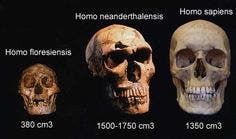
Reconstructed bust of H. Floresiensis. Credit: Karen Neoh, Flickr.
In 2004, researchers found a fossil skeleton in the island of Flores, Indonesia, which scientists think belongs to a new species of human called Homo floresiensis. The species is nicknamed the ‘hobbit’ due to the dwarfish stature of its individuals. H. floresiensis’ relationship to other species of humans remains enigmatic, but scientists hoped to learn more about it by studying a living pygmy population living near the Liang Bua cave where the fossils were originally found. A genetic analysis, however, shows that the population is unrelated to H. floresiensis — however, the Flores pygmies evolved some adaptations that may be similar to the ‘hobbits’.
Richard Green, an associate professor of biomolecular engineering at UC Santa Cruz, previously sequenced the DNA belonging to Neanderthals and Denisovans and found that the genomes of some modern humans include DNA sequences inherited from these archaic human species. The three species must have interbred in the distant past, which shows up in the genomes of people alive today in Southeast Asia, Melanesia, but also in Flores pygmies.
“Genetically, they’re not so different from other populations in that part of the world,” Green said.
Green and colleagues sequenced the genomes of 32 people in this population and found differences in genes related to height and diet.
The team found height-associated genes found in both Europeans and Flores pygmies, however, the latter genomes contained genetic variants associated with decreased height. This shows that short stature of Flores pygmies, whose average height is 145 centimeters (4.7 ft.), is the result of natural selection.
Likewise, natural selection acted upon genetic variants that code enzymes involved in fatty acid metabolism. These FADS enzymes (fatty acid desaturase) have been previously associated with dietary adaptations in other populations, such as the Inuit in Greenland.
“It suggests that something in the past caused their diet to change dramatically, and they adapted by natural selection favoring certain variants of those genes,” Green said.
[panel style=”panel-warning” title=”The mysterious ‘hobbits'” footer=””]Homo floresiensis is a possible species in the genus Homo, which may have lived up to as early as 13,000 years ago.
The tentative species of Homo is also called the ‘Hobbit’ due to the hominin’s small body and brain. These individuals stood 3 feet 6 inches (1 meter) tall, had large teeth for their small size, shrugged-forward shoulders, no chins, receding foreheads, and relatively large feet due to their short legs.
Scientists think that H. floresiensis’ diminutive stature and minuscule brain are the result of island dwarfism.[/panel]
Although there are no genetic elements that seem to have come from H. floresiensis, suggesting that Flores pygmies aren’t their descendants as previously posited, the findings are still striking. They show that the insular dwarfism which characterizes both populations arose twice and in at least two separate hominin lineages.
“If there was any chance to know the hobbit genetically from the genomes of extant humans, this would have been it. But we don’t see it. There is no indication of gene flow from the hobbit into people living today,” Green said in a statement.
When stuck on an island with limited food resources, but also fewer predators, larger animals tend to get smaller and small species tend to get larger. On the same island of Flores, a dwarf elephant used to live that was related to a now extinct species of mainland elephant. Conversely, the Flores giant rat is a prime example of the opposite tendency, which has individuals growing to at least twice the size of an average brown rat.
For now, the origin of Flores hobbits and their relationship to other species of humans remains a mystery. In time, however, it too might be dispelled as new findings emerge and scientists develop better tools.
The findings appeared in the journal Science.










